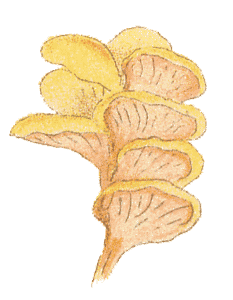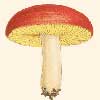 Introduction
Introduction
What's in this site and what isn't
The website introduces you to the basics of fungi that produce the striking (and easily visible) structures such as the mushrooms, puffballs, stinkhorns, polypores, truffles and so on. You saw a display of these in the opening page. These are the sorts of fungi that many people are familiar with, having seen them in gardens or in the bush. But even people who have seen these things may not have known the full story behind what they saw. Incidentally, if you don’t know what some of those structures are you can find out in the TYPES OF FUNGI SECTION.
This website will talk about fungi but not deal with the identification of fungi. Thus, there are discussions about topics such as what fungi are, fungal ecology and fungal biogeography.
The fungi treated in this website are commonly called the larger fungi or macrofungi - simply because they produce those easily visible structures mentioned in the first paragraph. In the WHAT IS A FUNGUS SECTION you’ll find out that the mushrooms, puffballs, stinkhorns and so on are simply the spore-producing parts of various fungi - with the rest of the fungus out of sight. By contrast the microfungi produce their spores in minute structures that are often hard to see with the naked eye. Microfungi are rarely mentioned on this website, even though there are far more microfungi than there are macrofungi and many microfungi are very important both economically or ecologically. Common examples of microfungi are yeasts, moulds, plant rusts and smuts, mildew and ringworm. While the words macrofungi and microfungi are very useful descriptive terms, they are not precise scientific terms - a bit like the words shrub and tree. Just as the boundary between a large shrub and a small tree is at times debatable, so is the boundary between macro and microfungi is imprecise.
 At
times you can see both together, such as in the photo on the right of
a microfungus growing on a mushroom (a macrofungus). Each of the black pin-heads
is a separate spore-producing structure.
At
times you can see both together, such as in the photo on the right of
a microfungus growing on a mushroom (a macrofungus). Each of the black pin-heads
is a separate spore-producing structure.
So, why don’t the microfungi get more of a mention? Simply because the expertise at the Australian National Botanic Gardens is with the macrofungi and they are also the fungi that we get questions about from the public. As you can see from the content of this website, there’s already an abundance of interesting features in the macrofungi alone.
On the few occasions when it is necessary to make the distinction between macrofungi and microfungi, those words will be used. Otherwise, for the sake of brevity, the word "fungi" will be used throughout this site and will mean macrofungi.
Edibility - can I eat it?
You won’t find out anything about edibility on this website. If your only interest is eating - then this website is not for you.
The photographs
Virtually all the photographs used in this website show fungi that are found in Australia. Many are endemic, but there are also species which are naturally widespread as well as a few that have been unintentionally introduced. In a few cases there are photographs of fungi that are not known to occur in Australia - but that will be made clear.
The links, camera and reference icons within the text
Most photos on the page are linked to larger versions of the same photo - just click on the photo to bring up the larger image in a new window. Close that window before proceeding.
There are many photos and drawings in the text, and you can bring up additional
photos whenever you see this camera icon: ![]() Just click on the icon to see the photo in a new window.
Just click on the icon to see the photo in a new window.
From time to time you’ll see grey Reference buttons which look
like this: ![]()
If you click on such a button you’ll find references to more detailed information
(generally in books or journals) about the topic being discussed at that point.
The references vary in level (some simple, others quite technical) but you don’t
need them to get a good grasp of the basics. The website will do that, so you
can safely ignore the references knowing that you are not missing out on anything
fundamental. The references are there simply for those who’d like to follow
up a topic in more depth. Close the little reference window before proceeding
further.
Links in UPPER-CASE lettering take you to different areas of the fungi web site. While most other links open up new windows within your current page, these links take you to new pages.
 The
painting at the top of a page
The
painting at the top of a page
In many cases you'll see a painting of a fungus at the top of a page. Most of these come from Handbook of Australian Fungi (written by M.C. Cooke and published in London in 1892). There’s more about Cooke in the HISTORY OF THE STUDY OF AUSTRALIAN FUNGI SECTION.
Friends of the Australian National Botanic Gardens
This web site was sponsored by the Friends of the Australian National Botanic Gardens, a non-profit support group for the Australian National Botanic Gardens. One of the objectives of the Friends is providing information and education to the community about growing, studying and promoting Australian plants. The Friends provided generous funding for the author, Heino Lepp, an Honorary Associate of the Gardens to write and develop this web site.
![An Australian Government Initiative [logo]](/images/austgovt_brown_90px.gif)

